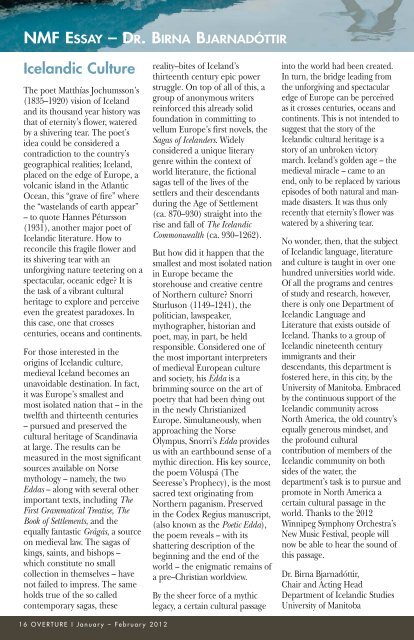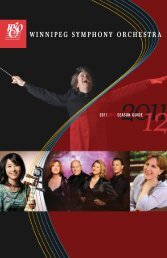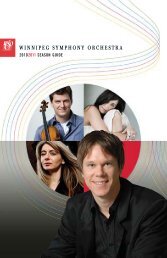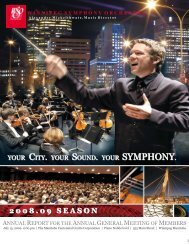New Music Festival - Winnipeg Symphony Orchestra
New Music Festival - Winnipeg Symphony Orchestra
New Music Festival - Winnipeg Symphony Orchestra
You also want an ePaper? Increase the reach of your titles
YUMPU automatically turns print PDFs into web optimized ePapers that Google loves.
NMF ESSAY – DR. BIRNA BJARNADÓTTIR<br />
Icelandic Culture<br />
The poet Matthías Jochumsson’s<br />
(1835–1920) vision of Iceland<br />
and its thousand year history was<br />
that of eternity’s flower, watered<br />
by a shivering tear. The poet’s<br />
idea could be considered a<br />
contradiction to the country’s<br />
geographical realities; Iceland,<br />
placed on the edge of Europe, a<br />
volcanic island in the Atlantic<br />
Ocean, this “grave of fire” where<br />
the “wastelands of earth appear”<br />
– to quote Hannes Pétursson<br />
(1931), another major poet of<br />
Icelandic literature. How to<br />
reconcile this fragile flower and<br />
its shivering tear with an<br />
unforgiving nature teetering on a<br />
spectacular, oceanic edge? It is<br />
the task of a vibrant cultural<br />
heritage to explore and perceive<br />
even the greatest paradoxes. In<br />
this case, one that crosses<br />
centuries, oceans and continents.<br />
For those interested in the<br />
origins of Icelandic culture,<br />
medieval Iceland becomes an<br />
unavoidable destination. In fact,<br />
it was Europe’s smallest and<br />
most isolated nation that – in the<br />
twelfth and thirteenth centuries<br />
– pursued and preserved the<br />
cultural heritage of Scandinavia<br />
at large. The results can be<br />
measured in the most significant<br />
sources available on Norse<br />
mythology – namely, the two<br />
Eddas – along with several other<br />
important texts, including The<br />
First Grammatical Treatise, The<br />
Book of Settlements, and the<br />
equally fantastic Grágás, a source<br />
on medieval law. The sagas of<br />
kings, saints, and bishops –<br />
which constitute no small<br />
collection in themselves – have<br />
not failed to impress. The same<br />
holds true of the so called<br />
contemporary sagas, these<br />
16 OVERTURE I January – February 2012<br />
reality–bites of Iceland’s<br />
thirteenth century epic power<br />
struggle. On top of all of this, a<br />
group of anonymous writers<br />
reinforced this already solid<br />
foundation in committing to<br />
vellum Europe’s first novels, the<br />
Sagas of Icelanders. Widely<br />
considered a unique literary<br />
genre within the context of<br />
world literature, the fictional<br />
sagas tell of the lives of the<br />
settlers and their descendants<br />
during the Age of Settlement<br />
(ca. 870–930) straight into the<br />
rise and fall of The Icelandic<br />
Commonwealth (ca. 930–1262).<br />
But how did it happen that the<br />
smallest and most isolated nation<br />
in Europe became the<br />
storehouse and creative centre<br />
of Northern culture? Snorri<br />
Sturluson (1149–1241), the<br />
politician, lawspeaker,<br />
mythographer, historian and<br />
poet, may, in part, be held<br />
responsible. Considered one of<br />
the most important interpreters<br />
of medieval European culture<br />
and society, his Edda is a<br />
brimming source on the art of<br />
poetry that had been dying out<br />
in the newly Christianized<br />
Europe. Simultaneously, when<br />
approaching the Norse<br />
Olympus, Snorri’s Edda provides<br />
us with an earthbound sense of a<br />
mythic direction. His key source,<br />
the poem Völuspá (The<br />
Seeresse’s Prophecy), is the most<br />
sacred text originating from<br />
Northern paganism. Preserved<br />
in the Codex Regius manuscript,<br />
(also known as the Poetic Edda),<br />
the poem reveals – with its<br />
shattering description of the<br />
beginning and the end of the<br />
world – the enigmatic remains of<br />
a pre–Christian worldview.<br />
By the sheer force of a mythic<br />
legacy, a certain cultural passage<br />
into the world had been created.<br />
In turn, the bridge leading from<br />
the unforgiving and spectacular<br />
edge of Europe can be perceived<br />
as it crosses centuries, oceans and<br />
continents. This is not intended to<br />
suggest that the story of the<br />
Icelandic cultural heritage is a<br />
story of an unbroken victory<br />
march. Iceland’s golden age – the<br />
medieval miracle – came to an<br />
end, only to be replaced by various<br />
episodes of both natural and manmade<br />
disasters. It was thus only<br />
recently that eternity’s flower was<br />
watered by a shivering tear.<br />
No wonder, then, that the subject<br />
of Icelandic language, literature<br />
and culture is taught in over one<br />
hundred universities world wide.<br />
Of all the programs and centres<br />
of study and research, however,<br />
there is only one Department of<br />
Icelandic Language and<br />
Literature that exists outside of<br />
Iceland. Thanks to a group of<br />
Icelandic nineteenth century<br />
immigrants and their<br />
descendants, this department is<br />
fostered here, in this city, by the<br />
University of Manitoba. Embraced<br />
by the continuous support of the<br />
Icelandic community across<br />
North America, the old country’s<br />
equally generous mindset, and<br />
the profound cultural<br />
contribution of members of the<br />
Icelandic community on both<br />
sides of the water, the<br />
department’s task is to pursue and<br />
promote in North America a<br />
certain cultural passage in the<br />
world. Thanks to the 2012<br />
<strong>Winnipeg</strong> <strong>Symphony</strong> <strong>Orchestra</strong>’s<br />
<strong>New</strong> <strong>Music</strong> <strong>Festival</strong>, people will<br />
now be able to hear the sound of<br />
this passage.<br />
Dr. Birna Bjarnadóttir,<br />
Chair and Acting Head<br />
Department of Icelandic Studies<br />
University of Manitoba











